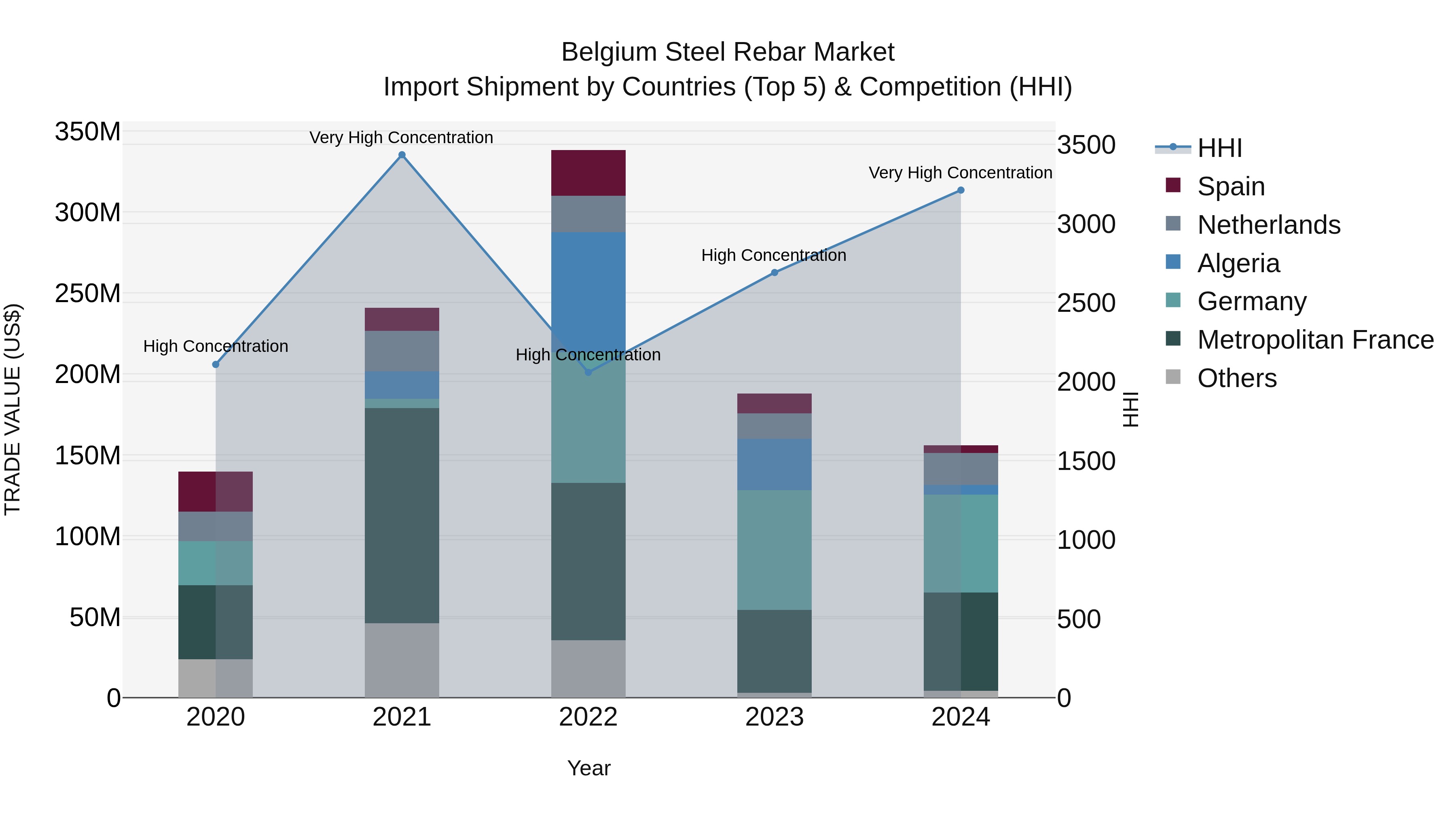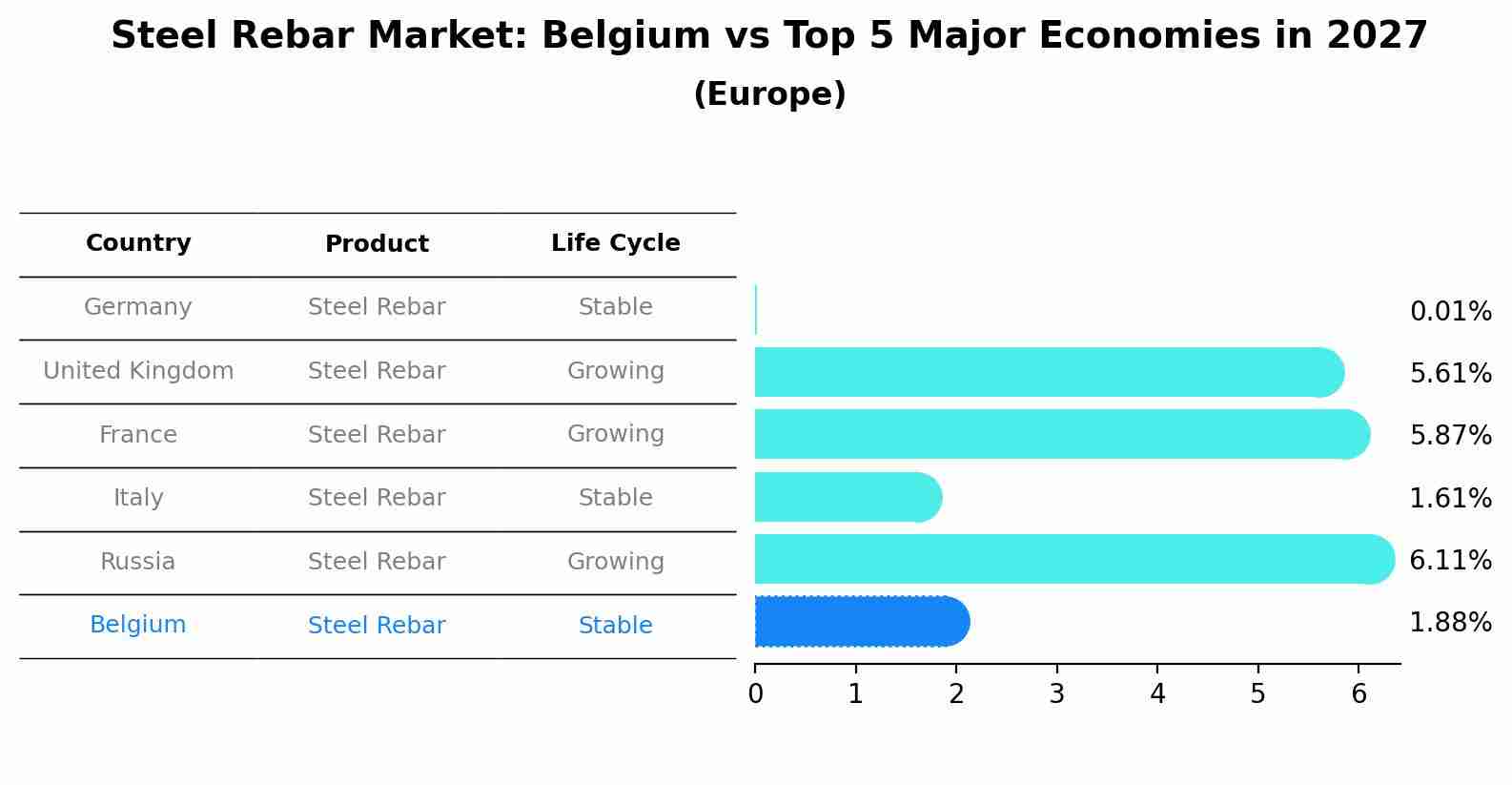Belgium Steel Rebar Market (2025-2031) | Value, Segmentation, Trends, Companies, Analysis, Share, Size, Revenue, Outlook, Industry, Growth & Forecast
| Product Code: ETC4979124 | Publication Date: Nov 2023 | Updated Date: Oct 2025 | Product Type: Market Research Report | |
| Publisher: 6Wresearch | No. of Pages: 60 | No. of Figures: 30 | No. of Tables: 5 | |
Belgium Steel Rebar Market Top 5 Importing Countries and Market Competition (HHI) Analysis
In 2024, Belgium continues to rely on key steel rebar imports primarily from Metropolitan France, Germany, Netherlands, Algeria, and Spain. The market shows a concerning trend towards even higher concentration, as indicated by the rising HHI. Despite the modest CAGR of 2.78% from 2020 to 2024, the negative growth rate of -16.98% in 2024 suggests potential challenges in the sector. Stakeholders should closely monitor these developments to assess the impact on the Belgian steel rebar market and consider strategic adjustments.


Steel Rebar Market: Belgium vs Top 5 Major Economies in 2027 (Europe)
In the Europe region, the Steel Rebar market in Belgium is projected to expand at a stable growth rate of 1.88% by 2027. The largest economy is Germany, followed by United Kingdom, France, Italy and Russia.

Key Highlights of the Report:
- Belgium Steel Rebar Market Outlook
- Market Size of Belgium Steel Rebar Market, 2024
- Forecast of Belgium Steel Rebar Market, 2031
- Historical Data and Forecast of Belgium Steel Rebar Revenues & Volume for the Period 2021-2031
- Belgium Steel Rebar Market Trend Evolution
- Belgium Steel Rebar Market Drivers and Challenges
- Belgium Steel Rebar Price Trends
- Belgium Steel Rebar Porter`s Five Forces
- Belgium Steel Rebar Industry Life Cycle
- Historical Data and Forecast of Belgium Steel Rebar Market Revenues & Volume By Type for the Period 2021-2031
- Historical Data and Forecast of Belgium Steel Rebar Market Revenues & Volume By Mild for the Period 2021-2031
- Historical Data and Forecast of Belgium Steel Rebar Market Revenues & Volume By Deformed for the Period 2021-2031
- Historical Data and Forecast of Belgium Steel Rebar Market Revenues & Volume By End-Use for the Period 2021-2031
- Historical Data and Forecast of Belgium Steel Rebar Market Revenues & Volume By Infrastructure for the Period 2021-2031
- Historical Data and Forecast of Belgium Steel Rebar Market Revenues & Volume By Residential Construction for the Period 2021-2031
- Historical Data and Forecast of Belgium Steel Rebar Market Revenues & Volume By Commercial Construction for the Period 2021-2031
- Belgium Steel Rebar Import Export Trade Statistics
- Market Opportunity Assessment By Type
- Market Opportunity Assessment By End-Use
- Belgium Steel Rebar Top Companies Market Share
- Belgium Steel Rebar Competitive Benchmarking By Technical and Operational Parameters
- Belgium Steel Rebar Company Profiles
- Belgium Steel Rebar Key Strategic Recommendations
Frequently Asked Questions About the Market Study (FAQs):
1 Executive Summary |
2 Introduction |
2.1 Key Highlights of the Report |
2.2 Report Description |
2.3 Market Scope & Segmentation |
2.4 Research Methodology |
2.5 Assumptions |
3 Belgium Steel Rebar Market Overview |
3.1 Belgium Country Macro Economic Indicators |
3.2 Belgium Steel Rebar Market Revenues & Volume, 2021 & 2031F |
3.3 Belgium Steel Rebar Market - Industry Life Cycle |
3.4 Belgium Steel Rebar Market - Porter's Five Forces |
3.5 Belgium Steel Rebar Market Revenues & Volume Share, By Type, 2021 & 2031F |
3.6 Belgium Steel Rebar Market Revenues & Volume Share, By End-Use, 2021 & 2031F |
4 Belgium Steel Rebar Market Dynamics |
4.1 Impact Analysis |
4.2 Market Drivers |
4.2.1 Increasing infrastructure development projects in Belgium |
4.2.2 Growing demand for sustainable construction materials |
4.2.3 Favorable government policies promoting the use of steel rebar in construction |
4.3 Market Restraints |
4.3.1 Fluctuating raw material prices impacting production costs |
4.3.2 Intense competition from alternative construction materials |
4.3.3 Economic uncertainties affecting investment in construction projects |
5 Belgium Steel Rebar Market Trends |
6 Belgium Steel Rebar Market Segmentations |
6.1 Belgium Steel Rebar Market, By Type |
6.1.1 Overview and Analysis |
6.1.2 Belgium Steel Rebar Market Revenues & Volume, By Mild, 2021-2031F |
6.1.3 Belgium Steel Rebar Market Revenues & Volume, By Deformed, 2021-2031F |
6.2 Belgium Steel Rebar Market, By End-Use |
6.2.1 Overview and Analysis |
6.2.2 Belgium Steel Rebar Market Revenues & Volume, By Infrastructure, 2021-2031F |
6.2.3 Belgium Steel Rebar Market Revenues & Volume, By Residential Construction, 2021-2031F |
6.2.4 Belgium Steel Rebar Market Revenues & Volume, By Commercial Construction, 2021-2031F |
7 Belgium Steel Rebar Market Import-Export Trade Statistics |
7.1 Belgium Steel Rebar Market Export to Major Countries |
7.2 Belgium Steel Rebar Market Imports from Major Countries |
8 Belgium Steel Rebar Market Key Performance Indicators |
8.1 Average selling price of steel rebar in Belgium |
8.2 Number of infrastructure projects utilizing steel rebar |
8.3 Adoption rate of steel rebar in new construction projects |
8.4 Percentage of steel rebar sourced from local manufacturers |
8.5 Investment in research and development for steel rebar innovations |
9 Belgium Steel Rebar Market - Opportunity Assessment |
9.1 Belgium Steel Rebar Market Opportunity Assessment, By Type, 2021 & 2031F |
9.2 Belgium Steel Rebar Market Opportunity Assessment, By End-Use, 2021 & 2031F |
10 Belgium Steel Rebar Market - Competitive Landscape |
10.1 Belgium Steel Rebar Market Revenue Share, By Companies, 2024 |
10.2 Belgium Steel Rebar Market Competitive Benchmarking, By Operating and Technical Parameters |
11 Company Profiles |
12 Recommendations | 13 Disclaimer |
- Single User License$ 1,995
- Department License$ 2,400
- Site License$ 3,120
- Global License$ 3,795
Search
Related Reports
- Vietnam System Integrator Market (2025-2031) | Size, Companies, Analysis, Industry, Value, Forecast, Growth, Trends, Revenue & Share
- ASEAN and Thailand Brain Health Supplements Market (2025-2031) | Strategy, Consumer Insights, Analysis, Investment Trends, Opportunities, Growth, Size, Share, Industry, Revenue, Segments, Value, Segmentation, Supply, Forecast, Restraints, Outlook, Competition, Drivers, Trends, Demand, Pricing Analysis, Competitive, Strategic Insights, Companies, Challenges
- ASEAN Bearings Market (2025-2031) | Strategy, Consumer Insights, Analysis, Investment Trends, Opportunities, Growth, Size, Share, Industry, Revenue, Segments, Value, Segmentation, Supply, Forecast, Restraints, Outlook, Competition, Drivers, Trends, Demand, Pricing Analysis, Competitive, Strategic Insights, Companies, Challenges
- Europe Flooring Market (2025-2031) | Outlook, Share, Industry, Trends, Forecast, Companies, Revenue, Size, Analysis, Growth & Value
- Saudi Arabia Manlift Market (2025-2031) | Outlook, Size, Growth, Trends, Companies, Industry, Revenue, Value, Share, Forecast & Analysis
- Uganda Excavator, Crane, and Wheel Loaders Market (2025-2031) | Strategy, Consumer Insights, Analysis, Investment Trends, Opportunities, Growth, Size, Share, Industry, Revenue, Segments, Value, Segmentation, Supply, Forecast, Restraints, Outlook, Competition, Drivers, Trends, Demand, Pricing Analysis, Competitive, Strategic Insights, Companies, Challenges
- Rwanda Excavator, Crane, and Wheel Loaders Market (2025-2031) | Strategy, Consumer Insights, Analysis, Investment Trends, Opportunities, Growth, Size, Share, Industry, Revenue, Segments, Value, Segmentation, Supply, Forecast, Restraints, Outlook, Competition, Drivers, Trends, Demand, Pricing Analysis, Competitive, Strategic Insights, Companies, Challenges
- Kenya Excavator, Crane, and Wheel Loaders Market (2025-2031) | Strategy, Consumer Insights, Analysis, Investment Trends, Opportunities, Growth, Size, Share, Industry, Revenue, Segments, Value, Segmentation, Supply, Forecast, Restraints, Outlook, Competition, Drivers, Trends, Demand, Pricing Analysis, Competitive, Strategic Insights, Companies, Challenges
- Angola Excavator, Crane, and Wheel Loaders Market (2025-2031) | Strategy, Consumer Insights, Analysis, Investment Trends, Opportunities, Growth, Size, Share, Industry, Revenue, Segments, Value, Segmentation, Supply, Forecast, Restraints, Outlook, Competition, Drivers, Trends, Demand, Pricing Analysis, Competitive, Strategic Insights, Companies, Challenges
- Israel Intelligent Transport System Market (2025-2031) | Strategy, Consumer Insights, Analysis, Investment Trends, Opportunities, Growth, Size, Share, Industry, Revenue, Segments, Value, Segmentation, Supply, Forecast, Restraints, Outlook, Competition, Drivers, Trends, Demand, Pricing Analysis, Competitive, Strategic Insights, Companies, Challenges
Industry Events and Analyst Meet
Our Clients
Whitepaper
- Middle East & Africa Commercial Security Market Click here to view more.
- Middle East & Africa Fire Safety Systems & Equipment Market Click here to view more.
- GCC Drone Market Click here to view more.
- Middle East Lighting Fixture Market Click here to view more.
- GCC Physical & Perimeter Security Market Click here to view more.
6WResearch In News
- Doha a strategic location for EV manufacturing hub: IPA Qatar
- Demand for luxury TVs surging in the GCC, says Samsung
- Empowering Growth: The Thriving Journey of Bangladesh’s Cable Industry
- Demand for luxury TVs surging in the GCC, says Samsung
- Video call with a traditional healer? Once unthinkable, it’s now common in South Africa
- Intelligent Buildings To Smooth GCC’s Path To Net Zero













